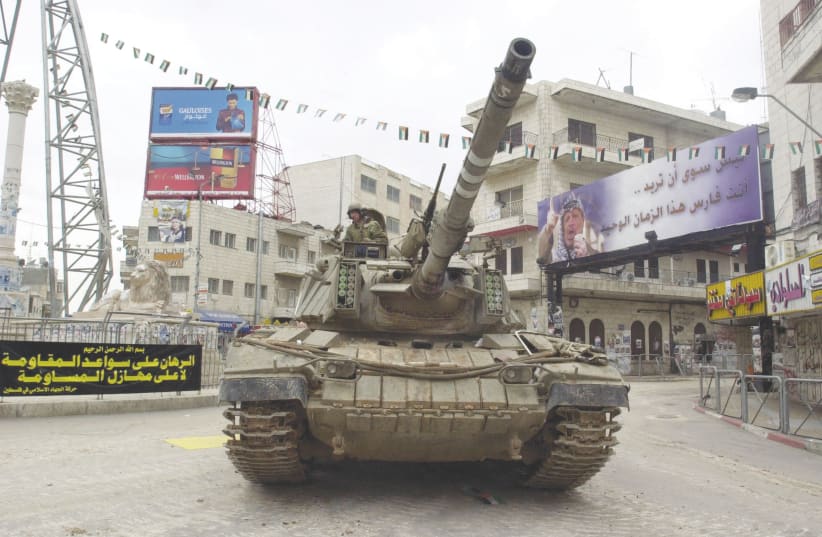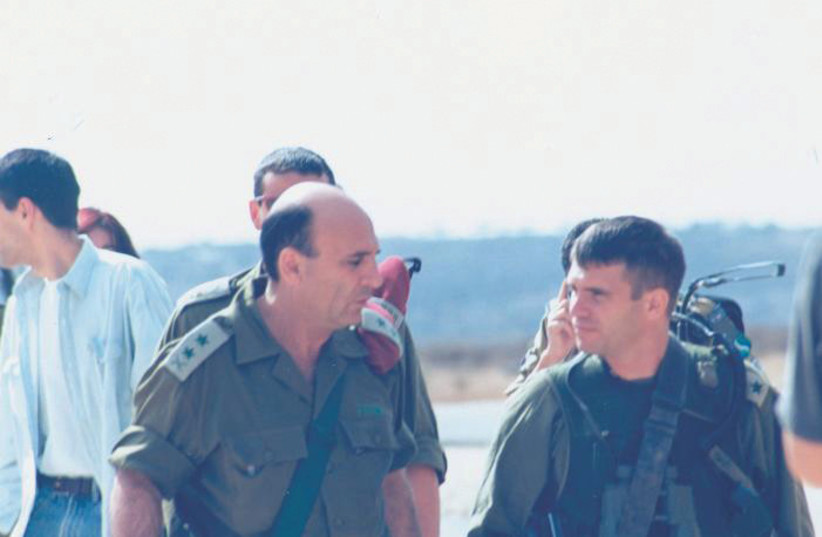Gal Hirsch had just arrived at his family’s home in the center of the country when his beeper went off. It was just after 7:20 p.m. on Seder night 2002, and the message informed him that a suicide bomber had blown himself up moments earlier in the dining room of the Park Hotel in Netanya.
Hirsch – at the time the Central Command’s head of operations – had only planned to spend a bit of time at his holiday meal anyhow, even without the Park Hotel bombing that killed 30 Israelis. The country was in the midst of the bloodiest month of the Second Intifada, the Palestinian uprising that saw a terrorist assault on Israel unlike anything it had ever experienced.
So when Hirsch received a phone call that March 27 night ordering him to immediately come to the Kirya for a meeting with the defense minister and chief of staff, there wasn’t even time for the first of the four cups of wine. He said Chag Sameach and bid his family farewell. As he left the home, some relatives poured water in his tracks, an old Sephardic custom based on the idea that just like water always returns home, so too will the person who is leaving for battle.
The meeting at IDF headquarters was short. Hirsch and other senior officers presented plans that had been in the making for some time, on how to reconquer the West Bank. Israel had spent years withdrawing from the heart of the Palestinian cities and the rest of Area A. The idea was simple to explain but hard to implement. Hirsch compared Palestinian terrorism in the West Bank to a fire, which needed a large blanket to cover and extinguish. The blanket was supposed to be the IDF.
After a few questions and a conversation between the defense minister and the prime minister, the order was given: the IDF had a green light to move ahead.
Hirsch ran back to his jeep and ordered his driver to take him straight to Central Command headquarters in northern Jerusalem. He spent the drive passing out orders, from what brigades and divisions to mobilize to which reserve units to draft.
A call came in from one of his officers.
“We are getting ready to activate the plan,” the officer said. “Should we stick with the name ‘Different Field?’”
“Give me a second,” Hirsch responded. “Different Field” was the random dry name that Hirsch and his officers had given the plans when they were still on paper. Now, they were about to come alive. He needed something that was more inspiring.
As he collected his thoughts, Hirsch looked out the window and saw Latrun, the former British Mandate police station now home to the IDF Armored Corps Museum, which in 1948 was the site of some of the fiercest battles of the War of Independence.
He was reminded of a poem by the famous Israeli songwriter and Israel Prize laureate Haim Hefer called “Between Borders”:
For the infant and the tender child, gates here we shall open. For the poor and the old we are here a defensive shield.
“Defensive Shield,” Hirsch told the officer. “That is what we will call the operation.”
The largest military operation in the West Bank since the 1967 Six Day War, Defensive Shield would last from March 29 until May 10.
Its effect is still felt today.
The name for the operation has also become a catchphrase for anytime Israel faces a new threat. People talk about launching a “Defensive Shield” in Gaza, a “Defensive Shield” against Arab crime and more.
THE BLANKET that Hirsch envisioned throwing over Judea and Samaria did not bring a complete end to terrorism – attacks still took place – but it brought the IDF back into the West Bank where it rounded up suspects, killed terrorists and destroyed infrastructure.
What it also did was restore what Israel had forfeited under the Oslo Accords – operational freedom, which is still needed 20 years later, as demonstrated this week with the latest IDF counter-terror operations.
As Hirsch recalled this week – Lahav Harkov and I spoke with him for the Jerusalem Post Podcast (it can be found on all podcast players) – IDF officers at the time respected the Oslo peace process and hoped, at least in the beginning, that the wave of terror would just be a bump in the road that could be quelled. They eventually understood that wasn’t the case.
“We were not allowed to be there,” Hirsch said of Area A, the part of the West Bank under complete Palestinian civil and security control. And it was not easy going back in.
During the years of Oslo, Yasser Arafat and his men had built up extensive terrorist infrastructure throughout the Palestinian cities. Money, donated by foreign governments, was diverted from civilian projects to purchase and fund terrorist capabilities.
“After the operation, the policy changed, and today we can go 24/7 and reach the bed of each terrorist and anyone who helps them. This is why after Defensive Shield... the situation in Israel completely changed.”
And it was unique at the time. The IDF – with five divisions, special forces and tens of thousands of reservists – entered every Palestinian city, hunted down the terror centers and went house-to-house, door-to-door and cave-to-cave to destroy the terrorist infrastructure. Thirty Israeli soldiers were killed and 127 were wounded.
Looking back, we asked Hirsch, what are the lessons today for the IDF?
First, he said, was the need to have operational freedom, something the IDF regained in the West Bank because of Defensive Shield and that was seen this past week when the IDF renewed counter-terror operations deep in Jenin, a sight not frequently seen in recent years.
What is also important to keep in mind, he stressed, is the need for legitimacy. Before 9/11, Israel’s “legitimacy battery” was empty after the Palestinians succeeded in presenting themselves as David and Israel as Goliath. That changed after the US came under attack and President George W. Bush declared a war on terrorism. Israel, he explained, felt a resurgence of confidence and support.
But the true legacy of the operation was the “Israeli spirit” illustrated by the high number of reservists who were drafted to fight in the operation: it wasn’t 100% attendance, it was 130%.
“The Israeli spirit was at its best those days,” Hirsch said. “It showed ourselves and the rest of the world that when the Israeli people stand up, they can dismantle any threat. This spirit is the most important legacy of Defensive Shield and it goes alongside the military capability of the IDF to confront any threat like this in the close region and the far region.”
Referring to the recent wave of terrorism in which 14 Israelis have been killed in attacks in Beersheba, Hadera, Bnei Brak and Tel Aviv, Hirsch said that while Israel needs to do everything it can to provide security, Israelis also need to remember that there is no such thing as 100% success.
“Terror exists, radical fundamentalists are there, and let’s not forget that we are facing a living spring of terrorism that produces terrorism 24/7: Iran.”
Commanders, Hirsch said, need to probe and learn the lessons from the failures that enable terrorists to cross into Israel and carry out attacks, “because by learning we can be one step ahead.”
But the enemy also learns, he added, and is also fast and agile, and is constantly looking for vulnerabilities and places they can infiltrate to carry out an attack.
“It happens worldwide and here – and we must make sure we have the strength to be effective and faster than our enemies.”
Twenty years ago, that is what Israel did. The fight is unfortunately still not over.

